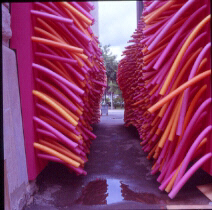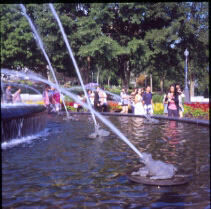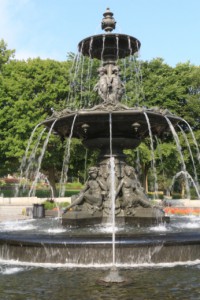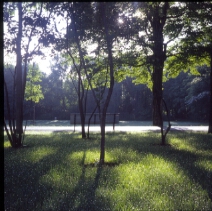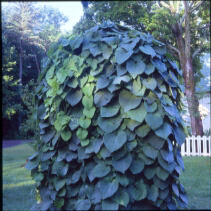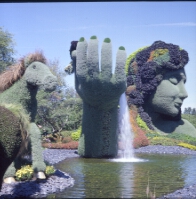I took these slides on the first day of spring, March 21, 2018. For those of you from balmier climes, yes, there can be this much snow in Montreal on the first day of spring. These snowmen had melted a little, and were starting to lose the form and details bestowed initially by their young creators. A couple of them have lost their eyes. Some of their features are starting to look a bit abstract. I initially saw them as somewhat nostalgic relics from the long winter we had been through, perhaps on a smaller time scale the way ruins remind us of a long-gone past, like the statues on Easter Island. My wife found them scary, as though they had escaped from a horror movie, and the more I examined them, the more I could see her point of view. Shot with a Heidoscop on a tripod with Fuji Provia 100F film. Exposures were as follows:
Snowman with a cap and scarf – 1/50th @ f25.
![]()
Snowman with small head – 1/20th @ f25.
![]()
Snowman with scarf and toque – 1/25th @ f25.
![]()
Snowman whose grapefruit eyes fell off – 1/40th @ f25.
![]()
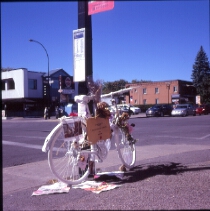
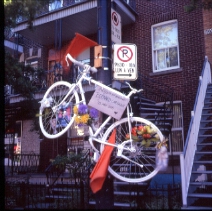
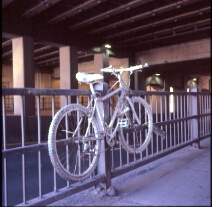
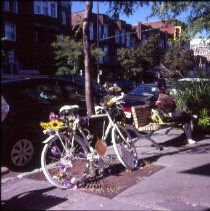
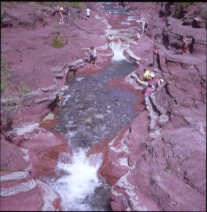 The red rocks provide an unusual background to this otherwise typical scene of people relaxing while enjoying an idyllic scene. The alluvial rocks in the stream bed are not red like the canyon, and have been carried down to the canyon from up the mountain. We fell in love with Waterton Lakes National Park in south-western Alberta during this our first visit. Original slide taken June 7, 2015 with a tripod-mounted Heidoscop using Provia 400X exposed at 1/160 at f16. This was my last roll of Provia 400X; it is sorely missed.
The red rocks provide an unusual background to this otherwise typical scene of people relaxing while enjoying an idyllic scene. The alluvial rocks in the stream bed are not red like the canyon, and have been carried down to the canyon from up the mountain. We fell in love with Waterton Lakes National Park in south-western Alberta during this our first visit. Original slide taken June 7, 2015 with a tripod-mounted Heidoscop using Provia 400X exposed at 1/160 at f16. This was my last roll of Provia 400X; it is sorely missed. These white dead trees create an otherworldly scene around many of the geysers at Yellowstone. I am not sure why living trees are growing amongst them: are the dead trees silicified and preserved, to be joined by the living trees when they succumb to the harsh environment; or perhaps the conditions have changed allowing a new generation of trees to survive; or perhaps the dead trees were burned in one of the many forest fires that occurred at Yellowstone before being covered in the minerals expelled by the geysers. Original slide taken June 1, 2015 with a tripod-mounted Heidoscop using Provia 400X exposed at an estimated 1/250 at f25.
These white dead trees create an otherworldly scene around many of the geysers at Yellowstone. I am not sure why living trees are growing amongst them: are the dead trees silicified and preserved, to be joined by the living trees when they succumb to the harsh environment; or perhaps the conditions have changed allowing a new generation of trees to survive; or perhaps the dead trees were burned in one of the many forest fires that occurred at Yellowstone before being covered in the minerals expelled by the geysers. Original slide taken June 1, 2015 with a tripod-mounted Heidoscop using Provia 400X exposed at an estimated 1/250 at f25. The Belgian Pool was named for a tourist from Belgium who was killed in 1929 after falling into the pool. Enthralled by an eruption of Grand Geyser, the unfortunate man apparently wasn’t watching where he was stepping. The range of colors is caused by the variation in the composition of the microbial mats caused by the change in temperature at different parts of the pool. (The colors would have been more intense with polarizing filters but I don’t have two polarizing filters. This more intimate scene is more effective with the regular lense separation of the Heidoscop than the shots I did of Old Faithful and other majestic scenes in Yellowstone and the Grant Tetons, most of which would have benefited from hyper stereo.) Original slide taken June 1, 2015 wit ha tripod-mounted Heidoscop using Provia 400X exposed at 1/200 at f22.
The Belgian Pool was named for a tourist from Belgium who was killed in 1929 after falling into the pool. Enthralled by an eruption of Grand Geyser, the unfortunate man apparently wasn’t watching where he was stepping. The range of colors is caused by the variation in the composition of the microbial mats caused by the change in temperature at different parts of the pool. (The colors would have been more intense with polarizing filters but I don’t have two polarizing filters. This more intimate scene is more effective with the regular lense separation of the Heidoscop than the shots I did of Old Faithful and other majestic scenes in Yellowstone and the Grant Tetons, most of which would have benefited from hyper stereo.) Original slide taken June 1, 2015 wit ha tripod-mounted Heidoscop using Provia 400X exposed at 1/200 at f22. Do these three crosses stand in memory of three people that lost their lives at this lonely crossroads? If yes, what complex lives are reduced to these simple white crosses? What happened? This shot was taken at intersection of US 287 and MT 200, north of Wolf Creek, Montana. The crosses are not present in Google streetview from June 2009. Original slide shot June 6, 2015 with a tripod-mounted Heidoscop using Provia 400X exposed at 1/160 at f25. (I was going to call the image “God Bless Ame”, after the billboard, but changed my mind as I felt it was going to change my intent.)
Do these three crosses stand in memory of three people that lost their lives at this lonely crossroads? If yes, what complex lives are reduced to these simple white crosses? What happened? This shot was taken at intersection of US 287 and MT 200, north of Wolf Creek, Montana. The crosses are not present in Google streetview from June 2009. Original slide shot June 6, 2015 with a tripod-mounted Heidoscop using Provia 400X exposed at 1/160 at f25. (I was going to call the image “God Bless Ame”, after the billboard, but changed my mind as I felt it was going to change my intent.)